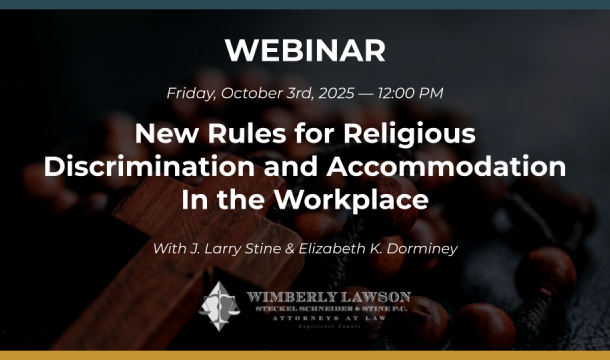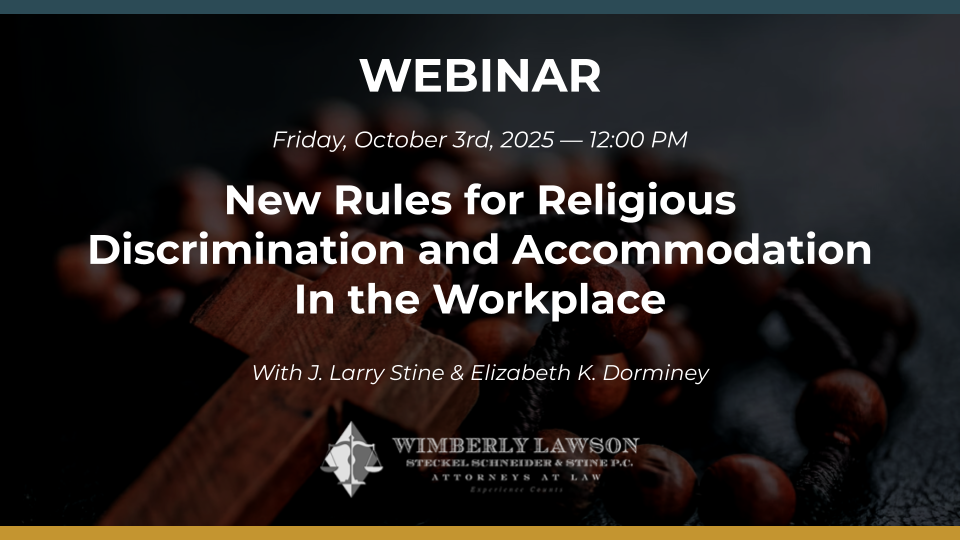COMPLYING WITH THE COVID-19 PAID LEAVE AND FMLA PROVISIONS AND ADDRESSING CORONAVIRUS
The Coronavirus is definitely the most important issue of the day, and so we are devoting the entire newsletter to this subject. Our firm has issued three Alerts during the week of March 16, 2020 on the above subjects, and this newsletter is intended to consolidate these various Alerts, as well as bring more recent information on the issues as of press time, March 26, 2020.
What Employers Must Comply With the Expanded FMLA Requirements?
The Families First Coronavirus Response Act (Act) changes the Family Medical Leave Act (FMLA) requirements for COVID-19 virus-related childcare leave situations to employers with fewer than 500 employees. Thus, all employers under 500 employees will be covered as long as their business affects commerce, which is the broadest application the law can have under the Constitution. The U.S. Department of Labor may exempt a small business under 50 employees if imposing the new childcare leave requirements would "jeopardize the viability of the business as a going concern," but such regulations have not yet been issued.
How Are the Normal FMLA Leave Provisions Expanded for Childcare Leave Situations?
The Act expands the normal FMLA provisions to allow eligible employees to take FMLA leave if the employee is unable to work (or telework) due to a need for leave to care for a son or daughter under 18 years of age if the school or place of care has been closed, or the childcare provider of such child is unavailable, due to the COVID-19 emergency.
How Much Notice for Such Expanded FMLA Leave Must the Employee Provide?
The Act provides in reference to the COVID-19 virus, where the necessity for leave is foreseeable, the employee shall provide the employer with such notice of leave as is practicable. Employers can likely require employees to follow their normal and reasonable notice procedures in order to receive such leave and/or paid time off.
How Much Documentation Can the Employer Require for the COVID-19-Related Leave?
Since the Act is basically an amendment of the FMLA, normal FMLA procedures can be followed in which employers may request an employee to furnish medical certification for the need for leave at the time the employee gives notice of the need for leave or within five (5) business days thereafter, but the employer may request certification at some later date if it has reason to question the appropriateness of the leave or its duration. It is likely that the existing government forms can be used or adapted for these purposes, such as WH-380E and WH-380F, although the government has made no announcements on whether these forms must be used or whether they will provide new forms for COVID-19-related purposes.
Can the Employer Require Return-to-Work Certification for Virus-Related Absences?
The normal FMLA rules will likely apply, in which employers can require employees to provide a return-to-work certification prior to returning from leave due to the employee's own serious health condition, provided that certification is uniformly required from all similarly-situated employees. Normal FMLA rules state that if the employer will require fitness-for-duty certification prior to restoring an employee to employment, it must provide the employee notice of the requirement with the FMLA-required designation notice.
What Are the Paid Leave Requirements?
The Act as finally passed provides two weeks of fully-paid sick leave (up to $511/day and $5,110 in the aggregate) for each employee's own COVID-19 related government ordered, or health care provider recommended, isolation or quarantine or absence due to seeking a medical diagnosis for COVID-19 symptoms. Two weeks of paid sick leave (up to $200/day and $2,000 in the aggregate) is available to the employee who is caring for (1) an individual (not defined in the Act) who is subject to government ordered, or health care provider recommended, isolation or quarantine; or (2) the son or daughter of the employee if the school or place of care has been closed due to COVID-19 precautions. Full time employees would be paid for 80 hours and part-time employees would be paid based upon their typical hours in a 2-week period. Paid sick leave under this provision is made available in addition to any existing paid sick leave policies of the employer. An employer may not require that the employee use other paid leave provided by the employer for use during this paid sick time.
After the two weeks of paid leave under the above provisions, if an employee is caring for a child whose school or daycare has been shut, the employee will be entitled to two-thirds of the employee's regular rate of pay for up to the remaining 10 weeks of FMLA leave. In other words, an employee that has been in quarantine or caring for a family member affected by the virus will not be eligible for the additional 10 weeks of paid leave. The Act provides that in no event shall such paid leave exceed $200.00 per day and $10,000.00 in the aggregate.
When Are Employees Eligible for the Expanded FMLA Leave and for Paid Leave?
The use of the two weeks of paid sick leave under the Act will be available for immediate use by the employee regardless of how long the employee has been employed by the employer. Expanded FMLA leave is only available to employees who have been employed for 30 days. If an employee is on lay-off rather than leave, it would appear that the expanded FMLA leave and paid leave provisions would not be applicable, but note that there are retaliation-discrimination provisions in the Act. If an employee is on leave at the time of the Act's effective date, April 1, 2020, it would appear the paid leave provisions could be applicable (if otherwise applicable) to the time period on or after April 1, 2020.
What is the Effective Date of this Law and How Long Does it Remain in Effect?
The effective date of the Act is April 1, 2020, and the requirements will expire on December 31, 2020.
Further Changes or Amendments Likely and Will There Be Any Relief for Small Business?
Further changes are very likely. The most likely candidate for change is to expand the application of the Act to larger employers, as the Act is currently limited to employers of less than 500 employees. Another likely change is further relief for small business. Further, numerous regulations will have to be issued as well as clarifications. Announcements are being issued virtually daily, and so this Alert is being offered only to give an overview as to where things seem to stand as of this date.
What Are the Tax Credits Available to Help Pay for the Cost of the Paid Leave Provisions?
Employers may recover some of the cost of the paid sick leave (under the Emergency Paid Sick Leave Act) via a tax credit applied to the employer's portion of FICA equal to the cost of qualified sick leave wages in a calendar quarter, but capped for each employee at $511/day for leave taken for an employee's own medical care, and capped at $200/day for leave taken to care for a family member. The credit is available for qualified sick leave wages paid during the period that begins on a date selected by the Secretary of the Treasury and ends December 31, 2020.
Employers may recover some of the cost of the paid family leave (under the Emergency Family and Medical Lease Expansion Act) via a tax credit applied to the employer's portion of FICA equal to the cost of qualified family leave wages. The tax credit for paid family leave taken under the expanded FMLA provisions is likewise capped per employee at $200/day and $10,000 in the aggregate. The credit is available for qualified family leave wages paid during the period that begins on a date selected by the Treasury Secretary and ends December 31, 2020.
What Are the Legal Implications of Asking Employees Questions Who Call In Sick and Requiring Employees to Stay at Home?
On March 18, 2020, the Equal Employment Opportunity Commission (EEOC) updated its guidelines about pandemics, specifically to cover issues related to COVID-19. The EEOC stated that during this pandemic employers may ask employees if they are experiencing symptoms, including symptoms such as fever, chills, cough, shortness of breath, or sore throat. Employees should not be asked if they have the virus itself, and they must maintain all such information as a confidential medical record. Employees who become ill with symptoms of COVID-19 may be required to leave the workplace and, as a general rule, the law does not interfere with employers following the advice of federal, state, and local health authorities. In hiring, employers may screen applicants for symptoms of COVID-19 after making a conditional job offer, as long as it does so for all entering employees of the same type.
What Has the Occupational Safety and Health Administration (OSHA) Said About COVID-19 and It's Prevention?
Another federal agency that has addressed the pandemic is the Occupational Safety and Health Commission (OSHA), which provided guidance in March, entitled "Guidance on Preparing Workplaces for COVID-19." This Guidance contains recommendations as well as descriptions of mandatory safety and health standards. The Guidance describes the symptoms of this virus as including fever, cough, and shortness of breath. However, others have experienced no symptoms at all. The symptoms may appear in as few as two days or as long as 14 days after exposure. The virus is thought to spread mainly from person-to-person, including:
- Between people who are in close contact with one another (within about six feet);
- Through respiratory droplets produced when an infected person coughs or sneezes.
While it may be possible that a person can get COVID-19 by touching a surface and then touching their own mouth, nose, or possibly their eyes, this is not thought to be the primary way the virus spreads. People are thought to be most contagious when they are most symptomatic. According to OSHA, for most employers protecting workers will depend on emphasizing basic infection prevention measures, including:
- Promote frequent and thorough hand washing, including by providing workers, customers and work site visitors with a place to wash their hands. If soap and running water are not immediately available, provide alcohol-based hand rubs containing at least 60% alcohol.
- Encourage workers to stay home if they are sick.
- Encourage respiratory etiquette, including covering coughs and sneezes.
- Provide customers and the public with tissues and trash receptacles.
- Discourage workers from using other workers' phones, desks, offices, or other work tools and equipment, when possible.
- Maintain regular housekeeping practices, including routine cleaning and disinfecting of surfaces, equipment, and other elements of the work environment. Products with EPA-approved emerging viral pathogens claims are expected to be effective against this virus.
- Prompt identification and isolation of potentially infectious individuals is a critical step in protecting workers.
- Encourage employees to self-monitor for signs and symptoms of COVID-19 if they suspect possible exposure.
- Employers should develop policies and procedures for employees to report when they are sick or experiencing symptoms of COVID-19
- Where appropriate, employers should develop policies and procedures for immediately isolating people who have signs and/or symptoms of COVID-19, and train workers to implement them.
- Take steps to limit spread of the respiratory secretions of a person who may have COVID-19, such as providing a face mask and asking the person to wear it.
- It may be difficult to require a healthcare provider's note for employees who are sick with acute respiratory illness to validate their illness as healthcare provider officers may not be able to provide such documentation in a timely way.
- Provide appropriate training and informational material about the issues, including proper hygiene practices, particularly since informed workers who feel safe at work are less likely to be unnecessarily absent.
What Has the Centers For Disease Control (CDC) Recommended as to the Virus?
Our firm has available the detailed Guidance from the CDC, but a few important items will be listed. Employees who have symptoms are recommended to stay home and not come to work until they are free of fever (100.4° F or greater), signs of a fever, or any other symptoms for at least 24 hours. Employees who appear to have acute respiratory illness symptoms (i.e., cough, shortness of breath) should be separated from other employees and be sent home immediately. Sick employees should cover their noses and mouths with a tissue when coughing or sneezing (or an elbow or shoulder if no tissue is available).
What Are the Editor's Recommendations of the Remaining Issues?
The Editor believes that it is important that all employers communicate with employees about the measures they have taken to protect their health and safety. Perhaps reasons should be expressed as to why the employer will continue to provide jobs, such as serving the economy and the market, and perhaps there should be a discussion of the new paid leave provisions to those employees that are eligible, particularly since they are going to find out about it anyway. The announcement might also include steps employers have already taken, including increasing the frequency of cleaning surfaces, placing additional hand sanitizing stations throughout, and monitory of medical recommendations. Coughing and sneezing etiquette and hand hygiene should also be summarized.
Employers with questions about the expanded FMLA, paid sick leave, and Coronavirus issues may contact one of our firm attorneys for assistance, particularly those listed below:
Larry Stine (jls@wimlaw.com), Jim Wimberly (jww@wimlaw.com, Kathleen Jennings (kjj@wimlaw.com) or Jim Hughes (jlh@wimlaw.com) at 404-365-0900.
Related Content
Get Email Updates
Recent Content

Trump Nominates Appointments to NLRB and EEOC but Policy Changes Likely to Be Delayed

DOL Launches Self-Audit Programs Designed to Help Employers Improve Compliance

DOL Must Release EEO-1 Reports to the Public under Open Records Laws

Current Advice on Active-Shooter Situations

New Policy for Federal Workers and Religious Expressions




